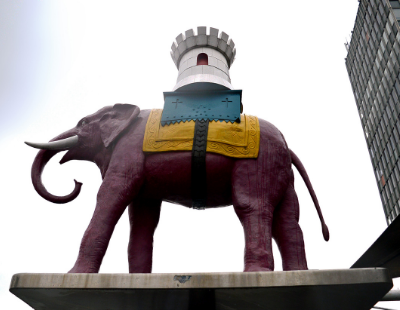But will it come to fruition, are the locals on side and will it be rivalling nearby Elephant & Castle in terms of new developments?
A road with a long past
With origins that can be traced back to an ancient path once used by the Celts more than 2,000 years ago, Old Kent Road formed part of a key route between London and the Kent coast in Roman times. This route, known as Watling Street, stretched from Dover to London, as well as further across the Midlands and into Wales.
Old Kent Road features in one of English literature’s most famous works – Geoffrey Chaucer’s The Canterbury Tales – and its long history is depicted in an impressive, Grade II listed ceramic mural, by Polish artist and refugee Adam Kossowski, mounted on the former North Peckham Civic Centre.
From its early roots as a rural thoroughfare linking London and Kent, the area was transformed into an industrial hotbed during the Victorian era – with the South Metropolitan Gasworks, the building of the Grand Surrey Canal and the arrival of the railways drastically changing its image.
Housing, businesses, industry and new infrastructure started to transform Old Kent Road, but much of this was then destroyed during heavy German bombing raids during World War II. The railway and canal became redundant by the 1970s, with the train depot in nearby Bermondsey turned into a trading estate and the canal filled in.
Post-war, the area became an odd mix of new council housing estates, retail warehouses and a traffic hub (thanks to the creation of the Bricklayers Arms junction and flyover) – while Burgess Park, now one of the largest parks in South London, was created to provide some much-needed greenery.
The historic road had lost its way as it struggled to recover from the destruction wreaked during the Second World War – little wonder, then, that it became the cheap brown square on the Monopoly board that no-one really wants.
A vision for change
This image is what the regeneration plans are aiming to consign to the dustbin of history. Fast-growing South London estate agency KALMARs certainly believes in the area’s potential, having recently announced its plan to open a new office on Old Kent Road as part of a wider inner London expansion.
“We are opening a KALMARs office on the Old Kent Road because of our clients’ increased need for consultancy and agency work, in particular in and around Old Kent Road,” Sebastian Kalmar, the firm’s residential sales director, said.
“We believe very strongly in the area’s potential and we want to make a further investment into the local community.”
Despite the general perception of Old Kent Road as cheap, shabby and a bit run-down, Sebastian believes this is an unfair reflection of an area that has plenty to offer and an exciting future.
“Many areas in London have been portrayed ‘negatively’ throughout the years and have recently become extremely desirable; Peckham, Brixton, Bermondsey to name just a few,” he explains.
“Old Kent Road is located between Bermondsey and Peckham, two of London’s coolest areas. The area is due to have one of South London’s greatest infrastructure improvements which will change what Old Kent Road has to offer and bring a change in public perception.”
Kalmar also claims that Old Kent Road has far more to offer in terms of variety than Elephant & Castle, its near neighbour and fellow regeneration hotspot (even though Elephant & Castle’s regeneration plans are currently well ahead of Old Kent Road in terms of delivery and developments).
“The Old Kent Road is going to have a much more diverse range in its offerings than Elephant and Castle due mainly to a greater selection of architects, developers and contractors in the area,” he says.
“Offerings will include some of the largest developers and architects in the country to local and independent companies. The Old Kent Road regeneration has a much greater focus on the concept of ‘beds and sheds’, mixing the requirement for industrial, logistical and residential properties.”
He adds: “Old Kent Road will also have a different offering in terms of transport. It is set to have the Bakerloo line extension but also a new Overground station on Surrey Canal Road.”
Kalmar says the regeneration is set to provide new workspaces, homes and jobs for existing businesses and local residents, as well as 7,000 new homes designated as affordable to help locals get onto the property ladder, which bats off the criticism that often gets levelled at regeneration projects – of gentrifying and effectively kicking out the locals as you regenerate.
He certainly sees a bright future for the area. “The Old Kent Road has long been a hub for industry and transport - both of which should continue but in a new and exciting way. The industry will be renewed and integrated with a residential offering. Transport will be regenerated in a much more sustainable manner. There is also set be an increase in public space, employment and much-needed housing."
KALMARs recently published a report – ‘The Transformation of Old Kent Road’ – providing a detailed review of how the area is already undergoing its £10.7 billion transformation, with ‘tired low-rise retail warehouses and factories’ being replaced by new apartment buildings and mixed-use developments.
The report argues that there are four key factors driving the regeneration of Old Kent Road: its designation as an ‘Opportunity Area’, its status as the forgotten part of central London given its close proximity to the City and West End, its exceptional growth potential and the proposed Bakerloo Line extension between Elephant & Castle and Lewisham, with two new stations on Old Kent Road itself.
The report highlights that on, or adjacent to, Old Kent Road, there are already 43 new residential or mixed-use developments either recently built, under development, granted planning consent or in the pipeline, providing approximately 8,000 new homes. It also found that new homes developments on Old Kent Road can command values of £700 to £800 per sq ft.
Lastly, the report claims that there are three distinct zones of development in the pipeline or being planned along Old Kent Road:
1. Niche residential schemes of less than nine homes/apartments, typically four to six storeys in height with contemporary glass and brick facades.
2. Medium-sized schemes providing between 20-130 homes/apartments, typically 6-15 storeys in height, some with commercial facilities.
3. Large urban regeneration projects, providing between 180 and 1,300 homes/apartments, up to 48 storeys high, complete with new retail, commercial and community/leisure facilities, undertaken by leading urban regeneration experts such as Berkeley Homes, Galliard Homes and L&Q.
Slow progress the only progress so far
At present, when walking along the road, there is little to suggest the £10 billion scheme is underway. It’s an interesting, if shabby, part of town – with the road seeming to go on forever.
There is a pleasing lack of chain restaurants or coffee shops, the obligatory McDonald’s, Domino’s and KFC stores aside. At the same time, some of the shopfronts have seen better days and the architecture of most of the buildings is unremarkable to say the least. There are also a number of large retail warehouse-type buildings and out-of-town supermarket superstores which are pretty soulless.
That said, much like Elephant & Castle, it has character. There is a strong South/Latin American feel, from Bolivian and Ecuadorean cafes to the Iglesia la Luz del Mundo (Church of the Light of the World), plenty of places to eat from all over the globe, and landmarks like the Soviet T-34 tank at the end of Pages Walk and Mandela Way and the blue plaque signalling where heavyweight champion Sir Henry Cooper used to train (in the gym above the now closed Thomas A Becket pub).
What is the latest?
At the start of October, residents were encouraged to have their say on whether regeneration along Old Kent Road will bring benefits to local people.
Southwark council’s Cabinet approved a draft version of a Social Regeneration Charter for Old Kent Road which is now out for consultation until 4 November, with the Charter including ten promises to local people living and working in the Old Kent Road area.
TfL also recently announced a ten-week consultation into the most detailed plans yet for the Bakerloo Line extension, with calls for suggestions for the names of the two proposed Bakerloo stations on Old Kent Road.
The first proposed station, at the junction with Dunton Road, could be called ‘Old Kent Road’ or ‘Burgess Park’, said TfL, while the second, at the junction with Asylum Road, could also be called ‘Old Kent Road’ or ‘Asylum’.
The whole project seems a little bit in limbo at the moment, but the potential for the area is undeniable. Whether the locals and the property developers are on the same page, however, remains to be seen.
The next part of this series will focus on the Canada Water Masterplan







.png)



.jpg)





Join the conversation
Be the first to comment (please use the comment box below)
Please login to comment